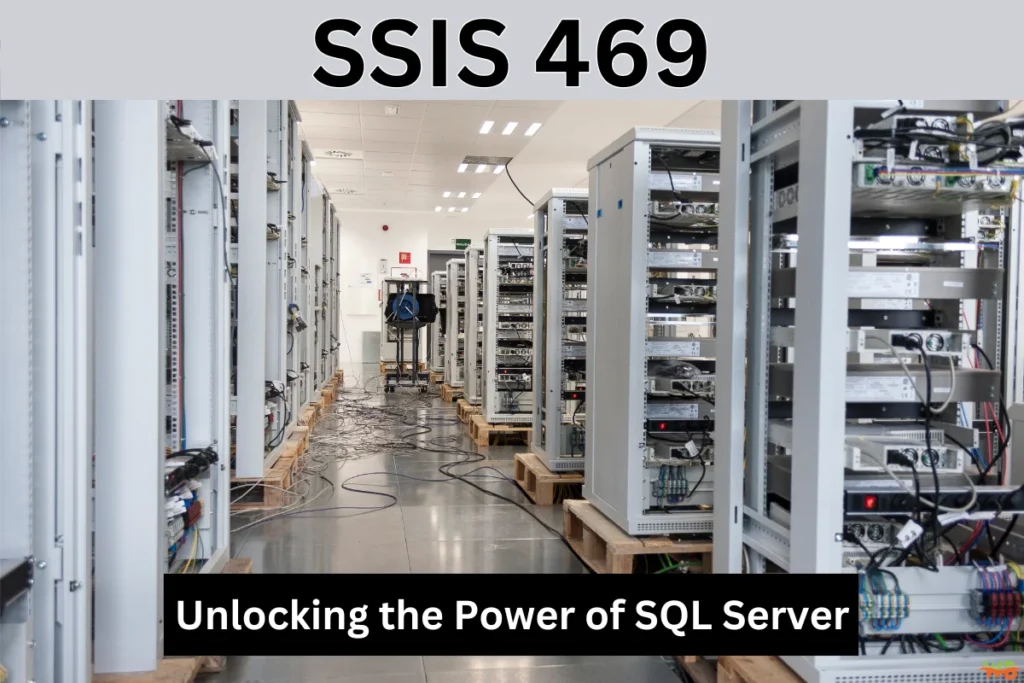In today’s information-driven landscape, organizations often face challenges in managing and integrating large volumes of data. This is where SSIS 469 (SQL Server Integration Services) comes in as an effective solution for ETL (Extract, Transform, Load) processes. SSIS 469 is a powerful tool designed by Microsoft to streamline data integration, making it easier for businesses to manage and leverage their data for better decision-making.
In this article, we will dive deep into the key features, benefits, and use cases of SSIS 469, offering a comprehensive guide on how this tool can enhance your organization’s data integration processes. We’ll also explore challenges, best practices, and future trends in SSIS development. Let’s unlock the potential of SSIS 469 and understand how it can drive business success.
What is SSIS 469 and How Does It Function?
SSIS 469, a sturdy ETL (Extract, Transform, Load) solution, originated by Microsoft. Data can be extracted from a variety of sources, converted into a format that can be used, and then loaded into databases or other locations for analysis and reporting. It is a component of the SQL Server suite. With its advanced features and robust performance, SSIS 469 is crucial for organizations that deal with large volumes of data across different systems.
Key Features of SSIS 469
SSIS 469 offers an array of features that make it a preferred choice for data integration tasks. Let us evaluate the main aspects of it in more detail:
1. Flexible ETL Processes
SSIS 469 provides a visual development environment that enables you to create highly customized ETL operations. This user-friendly interface lets you drag and drop tasks and transformations to create complex workflows. It’s ideal for organizations with diverse data integration needs, enabling you to adapt the ETL process based on specific business requirements.
2. Connectivity Options
The broad array of connectivity scenarios offered by SSIS 469 is one of its best traits. SQL Server, Oracle, MySQL, CSV files, XML, Excel spreadsheets, and cloud platforms like Azure services are just a few of the data sources it regulates. This flexibility ensures that SSIS 469 can integrate data from almost any system, making it highly adaptable for organizations with multiple data sources.
3. Advanced Data Transformation Capabilities
The transformation process is where SSIS 469 shines. With its rich set of built-in transformations, you can cleanse, aggregate, merge, and split data effortlessly. Whether you need to standardize data formats, filter out irrelevant information, or perform complex calculations, this tool has you covered. This ensures that the data you load is accurate, consistent, and ready for use in reporting or analytics.
4. Scalability and Performance
As your organization grows and the volume of data increases, scalability becomes crucial. SSIS 469 is built to efficiently manage large volumes of data. It can scale horizontally by distributing workloads across multiple servers or nodes, ensuring that performance remains optimal even under heavy data loads.
5. Robust Monitoring and Logging
SSIS 469 includes powerful monitoring and logging tools that track package execution and provide insights into system performance. The SSISDB catalog stores and manages package execution logs, while the Integration Services Dashboard offers real-time visual feedback on execution status. This helps administrators quickly identify and resolve any issues that arise during the data integration process.
Use Cases of SSIS 469
The versatility of SSIS 469 allows it to be used in a variety of data integration scenarios. Below are some of the most common use cases where SSIS 469 shines:
1. Data Warehousing
Data warehousing is one of the primary applications of SSIS 469. It makes it easier to collect data from multiple sources, convert it into a common format, and load it into a data warehouse for reporting and analysis. By leveraging this tool, organizations can streamline their data warehousing processes, ensuring accurate and timely information for decision-making.
2. Data Migration
Data migration is a further noteworthy use case for SSIS 469. Whether moving data from legacy systems to modern databases or consolidating data from multiple sources, the tool simplifies the process. It guarantees that data is sent smoothly while preserving data integrity because to its strong data handling and transformation capabilities.
3. Real-time Data Processing
With the rise of real-time analytics, SSIS 469 now supports real-time data processing. This allows businesses to process and analyze data as it is generated, enabling quicker decision-making and enhanced operational efficiency. For organizations that need to act on data in near real-time, the tool provides the necessary tools to achieve this.
Challenges and Limitations of SSIS 469
While SSIS 469 offers powerful capabilities, it is not without its challenges. The following are some potential restrictions that users could run into:
1. Complexity in Package Development
The visual development environment makes it easier to design ETL workflows, but complex data transformations and integrations can still be time-consuming and difficult to manage. It may require advanced knowledge of SSIS features and SQL to develop efficient packages for large-scale data integration.
2. Performance Bottlenecks in Large-Scale Projects
Although SSIS 469 is designed for scalability, large-scale projects with massive datasets may still experience performance bottlenecks. Optimizing package execution and ensuring that system resources are efficiently used requires careful planning and configuration.
3. Compatibility with Legacy Systems
Another challenge is compatibility with older, legacy systems. While the tool supports a wide variety of data sources, certain older systems may require additional configurations or custom solutions to integrate smoothly.
Best Practices for Using SSIS 469 Effectively
To get the most out of SSIS 469, follow these best practices:
1. Design Modular and Reusable Packages
Designing modular packages makes it easier to maintain and reuse them across multiple ETL processes. Breaking complex workflows into smaller, more manageable parts helps improve efficiency and minimize errors.
2. Implement Robust Error Handling and Logging
Error handling is essential to ensure that your data integration processes run smoothly. Implementing error handling within SSIS 469 helps you catch issues early on, while logging provides a detailed history of package executions, helping you troubleshoot problems more effectively.
3. Optimize Performance
To enhance performance, fine-tune the configuration of your SSIS 469 packages. This includes choosing the appropriate data types, using parallel processing where possible, and tuning the system for specific workloads. Performance optimization ensures that your packages run efficiently, even with large datasets.
Future Trends in SSIS 469
SSIS 469 is anticipated to see a number of developments as data integration requirements constantly change. The coming years to look out for include what’s to come:
1. Cloud Integration
With more organizations shifting to cloud-based systems, future versions of SSIS 469 may feature enhanced cloud integration capabilities. This will allow for smoother data flows between on-premises systems and cloud platforms like Microsoft Azure.
2. Machine Learning Integration
As machine learning becomes more prevalent in business operations, it could integrate with machine learning models to enhance data processing and decision-making capabilities.
3. Containerization and Automation
To improve scalability and deployment efficiency, future versions of SSIS 469 may incorporate containerization and automation features, allowing organizations to deploy and scale data integration packages with greater ease.
Conclusion: Why SSIS 469 is a Must-Have for Data Integration
In conclusion, SSIS 469 is a powerful and flexible ETL solution that streamlines data integration processes, helping organizations manage, transform, and analyze large volumes of data more effectively. Whether you’re working on data warehousing, data migration, or real-time data processing, the tool offers the features and scalability needed to meet your organization’s data integration needs.
By following best practices and leveraging its advanced features, businesses can optimize their data workflows, improve decision-making, and enhance operational efficiency. With its proven capabilities and potential for future innovation, it is a critical tool for any organization looking to stay ahead in the data-driven world.
FAQs
1. Can the tool be used for non-relational data sources?
- Yes, the tool can integrate data from both relational and non-relational sources. It supports various file formats, including CSV, XML, and flat files, as well as cloud platforms like Azure. This makes it a flexible solution for managing different types of data, including semi-structured and unstructured data.
2. How does the tool handle data errors during the ETL process?
- The tool offers robust error-handling capabilities. During the ETL process, you can set up error flows that capture and manage exceptions. You can configure the system to log errors, redirect erroneous rows to a separate output file, or even halt the entire process depending on the severity of the issue.
3. Can packages be scheduled to run automatically?
- Indeed, the tool allows you to schedule packages through SQL Server Agent. This allows you to automate ETL processes, ensuring that they run at predefined times without manual intervention. You can set up recurring schedules for tasks like data extraction and transformation at regular intervals.
4. Can the tool integrate with third-party tools and applications?
- Yes, the tool can integrate with third-party applications through custom components or scripts. By using .NET languages like C# or VB.NET, you can extend its functionality to interact with non-Microsoft tools or services. Additionally, there are many connectors and third-party plug-ins available for more specialized integrations.
5. How do I monitor the performance of the packages?
- The tool provides built-in tools for monitoring package performance, including the Integration Services Dashboard and the SSISDB catalog. These tools offer insights into execution statistics, logging, and performance metrics. You can track the status of running packages, identify slow-running tasks, and optimize processes based on the insights provided.

Ton Roobprom is an experienced writer focused on practical advice across technology, business, travel, beauty, lifestyle, and home improvements. He specializes in distilling complex subjects into clear, actionable insights to help you enhance your daily life.





